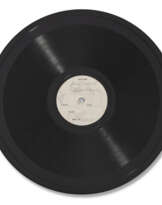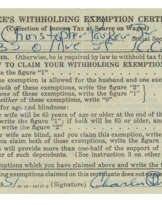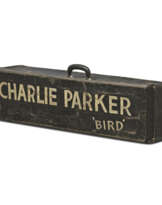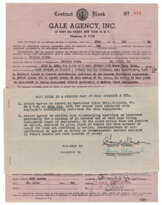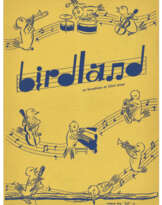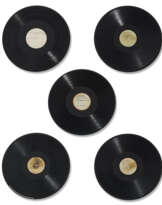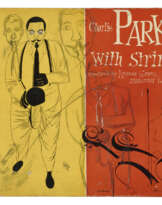Two autograph music manuscripts of trumpet parts for the songs Swedish Schnapps and Back Home Blues, used during recording of the album Swedish Schnapps, 1951
28.09.2023 13:00UTC +00:00
Classic
Verkauft
13860GBP £ 13 860
| Auctioneer | CHRISTIE'S |
|---|---|
| Veranstaltungsort | Vereinigtes Königreich, London |
| Aufgeld | see on Website% |
Archiv
Die Auktion ist abgeschlossen. Es können keine Gebote mehr abgegeben werden.

ID 1016458
Los 187 | Two autograph music manuscripts of trumpet parts for the songs Swedish Schnapps and Back Home Blues, used during recording of the album Swedish Schnapps, 1951
Schätzwert
£ 6 000 – 8 000
Charles “Charlie,” Jr. Parker
PARKER, Charles “Charlie,” Jr. (1920-1955).
Two autograph music manuscripts of trumpet parts for the songs Swedish Schnapps and Back Home Blues, used during recording of the album Swedish Schnapps, 1951.
Two short arrangements of trumpet parts in the hand of Charlie Parker, pencil on half-sheets of dual twelve stave paper by King Brand, manually separated at the folds, 314 x 241 mm, untitled but being the trumpet parts for Swedish Schnapps and Back Home Blues, the first 8 bars with repeats on 3 staves, the second 12 bars on 5 staves, the parts written out for trumpeter Red Rodney and used during a studio recording session with Norman Granz on 8 August 1951 in New York City for Mercury Records, with Parker, Rodney, pianist John Lewis, bassist Ray Brown and drummer Kenny Clarke, billed as the Charlie Parker Quintet; together with a third manuscript on one side of a stave paper fragment, 199 x 249 mm, untitled but being the trumpet part for Si Si, 12 bars on the first 5 staves, and the alto part for Ah Leu Cha, 8 bars and one bar rest with repeats on the next 3 staves, written out in black ink in an unknown hand, possibly that of pianist John Lewis, and signed off in ink by Charlie Parker below the notation, Si Si recorded during the same Mercury session on 8 August.
A trumpet part for Si Si was originally written out in pencil by Parker - with an alto part for Ah Leu Cha on the reverse - and sold through these rooms alongside the manuscripts for Swedish Schnapps and Back Home Blues as part of the Chan Parker Collection in 1994. The present fragment appears to be a copy of Parker’s Si Si manuscript, hastily copied out in black ink for studio use, consolidating the two parts together on the same page, and signed off by Parker. Phil Schaap’s liner notes to The Verve Sessions, 1998, quote Red Rodney as suggesting that pianist John Lewis notated Parker’s pieces, so it’s possible that the present fragment is a copy in Lewis’ hand.
Although at the peak of his popularity in 1951, Parker found himself in an endless feud with the authorities that directly controlled access to the clubs and bars that sustained his livelihood - his “cabaret card” had been revoked on suspicion of narcotics possession, preventing him from working in New York City jazz clubs for over a year, and forcing him out on the road and into the studio. ‘Charlie returned to New York,’ writes Ross Russell, ‘and reassembled the Quintet for a Mercury record date. Flown down [from the Catskills] by charter plane at Charlie's insistence, [Red] Rodney joined John Lewis, Ray Brown, and Kenny Clarke to record Swedish Schnapps, Si Si, Blues for Alice, Back Home Blues, and a long postponed remake of Lover Man.' In Yardbird Suite, Parker scholar Lawrence A. Koch notes that ‘the level of musicianship is extremely high on these recordings, and although they are not as highly-touted as some of Bird’s more flamboyant efforts, the overall performance should be ranked as one of Parker’s best. The unisons are flawless, solos excellent, and the rhythm section tight... Back Home and Si Si are all blues, each possessing a different personality; and Schnapps is an I Got Rhythm derivative with an improvised bridge.’ Although Swedish Schnapps is credited to Charlie Shavers on the record label, Koch opines that, like Back Home Blues, it is also a Parker composition: ‘one has only to hear it once to realize it is a Parker original.’
Music manuscripts by Parker are incredibly scarce – he often eschewed sheet music and left few original manuscripts behind, beyond a number of lead sheet deposits in the Library of Congress. In Charlie Parker, Composer, Henry Martin explains ‘Parker left so few manuscripts, probably because he mostly composed in his head and then wrote out what he needed to, often as a trumpet part.’ The 8 August 1951 recording session is unique in that autograph manuscripts exist for all four Parker compositions that were recorded. With reference to the present manuscripts, Martin illustrates that there are only minor differences to the tracks as recorded, noting on Swedish Schnapps that ‘the phrasing in m. 4 is slightly revised’, and on Back Home Blues that Parker and Rodney ‘had little difficulty with its melody and so, not surprisingly, there are few differences...’, other than a small alteration ‘so as to syncopate the G4 and D5. The revision is funkier and better fits the character of the piece, although it’s possible that the final was how Parker originally conceived of the melody but notated it inexactly.’ As a composition Swedish Schnapps ‘shows off a winning melody and a sunny character’, writes Martin, and calls Back Home Blues a ‘fine work, with memorable beginnings’, noting that ‘the unusual character of “Back Home” provides a foil to Parker’s uptempo bebop works.’ Koch, 217. Martin, 155-162, 220-1, 292-6. Russell, Bird Lives! 305.
Housed in a modern custom quarter morocco blue cloth slipcase and chemise. Provenance: The Chan Parker Collection, Christie’s London, 8 September 1994, lots 79 & 80.
| Adresse der Versteigerung |
CHRISTIE'S 8 King Street, St. James's SW1Y 6QT London Vereinigtes Königreich | |
|---|---|---|
| Vorschau |
| |
| Telefon | +44 (0)20 7839 9060 | |
| Aufgeld | see on Website | |
| Nutzungsbedingungen | Nutzungsbedingungen |


